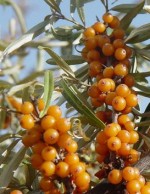 Grown in China for twelve centuries for its medicial uses this spiny deciduous shrub may become the next health food fad but is a useful garden plant too. The outstanding feature of the plant is clusters of pale yellow to dark orange edible fruit which contains more vitamin C than oranges or lemons. The fruits ripen in the fall and persist into the winter. The inconspicuous flowers lack petals and are produced in the spring with male and female flowers on separate plants. One male plant can service several females but a male plant must be in the area for berries to be produced. The narrow leaves are gray-green on the upper side, silvery on the bottom with a rough surface. The root system is extensive making the plant valuable for soil stabilization. The roots also fix nitrogen from the air and transform insoluble chemicals in the soil into soluble forms so that they are more available to plants. Sea buckthorn tolerates salty conditions, drought, and a large variety of soil types including wet ones. It is especially useful for seaside plantings but can be used effectively in borders and the sunny locations of woodland gardens. Sea buckthorn is a member of the oleaster family, Eleagnaceae, that also includes Eleagnus. The genus name, Hippophae, is the classcial Greek name for another plant probably prickly spurge. The name comes from the Greek words hippo meaning horse, and phaos to shine and may refer to the anceint Greek use of sea buckthorn leaves as horse fodder to make their coasts shine. The specific epithet, rhamnoides, means resembling Rhamnus, the genus to which buckthorns belong.
Grown in China for twelve centuries for its medicial uses this spiny deciduous shrub may become the next health food fad but is a useful garden plant too. The outstanding feature of the plant is clusters of pale yellow to dark orange edible fruit which contains more vitamin C than oranges or lemons. The fruits ripen in the fall and persist into the winter. The inconspicuous flowers lack petals and are produced in the spring with male and female flowers on separate plants. One male plant can service several females but a male plant must be in the area for berries to be produced. The narrow leaves are gray-green on the upper side, silvery on the bottom with a rough surface. The root system is extensive making the plant valuable for soil stabilization. The roots also fix nitrogen from the air and transform insoluble chemicals in the soil into soluble forms so that they are more available to plants. Sea buckthorn tolerates salty conditions, drought, and a large variety of soil types including wet ones. It is especially useful for seaside plantings but can be used effectively in borders and the sunny locations of woodland gardens. Sea buckthorn is a member of the oleaster family, Eleagnaceae, that also includes Eleagnus. The genus name, Hippophae, is the classcial Greek name for another plant probably prickly spurge. The name comes from the Greek words hippo meaning horse, and phaos to shine and may refer to the anceint Greek use of sea buckthorn leaves as horse fodder to make their coasts shine. The specific epithet, rhamnoides, means resembling Rhamnus, the genus to which buckthorns belong.
Type: Deciduous shrub or small tree
Outstanding Feature: Berries
Form: Upright, suckering, forming colonies
Growth Rate: Fast
Bloom: Inconspicuous apetalous male and female flowers on separate plants in spring; pale yellow to orange berries ripen in fall
Size: 20’ H x 15’ W
Light: Full sun
Soil: Average, dry to moist; tolerates infertile soil and range of pH.
Hardiness: Zones 3-7
Care: Low maintenance
Pests and Diseases: None of significance but susceptible to Verticillium wilt, Fusarium wilt, aphids, thrips, mites, earwigs, gall tick, leaf roller, gypsy mother, scale, sea buckthorn fly.
Propagation: Seed sown in fall as soon as ripe or sown in spring (cold stratification may improve germination); half ripe cuttings in summer; cuttings of mature wood in fall; division of suckers in winter; laying in fall.
